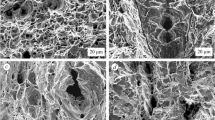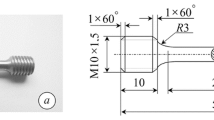Abstract
In sheets of low-alloy pipe steels with high purity by harmful impurities and non-metallic inclusions, the nucleation and propagation sites of hydrogen-induced cracking (HIC) are extended segregation bands of increased hardness in the axial zone, with sections consisting of high-carbon structures. The use of intensive cooling after controlled rolling from the austenitic region to the bainitic transformation temperatures and a decrease in the concentration of liquor carbon and manganese in steel helps to increase the sheet resistance to HIC due to reducing central segregation heterogeneity.











Similar content being viewed by others
REFERENCES
API Specification 5L, Washington, DC: API, 2018, 46th ed.
ISO 3183:2012: Petroleum and Natural Gas Industries—Steel Pipe for Pipeline Transportation Systems, Geneva: Int. Stand. Org., 2012.
STO 2-4.1-223-2008. Tekhnicheskie trebovaniya k elektrosvarnym serovodorodostoikim trubam (STO 2-4.1-223-2008. Technical Requirement to Electrowelded Hydrogen Sulfide Resistant Pipes), Moscow: Gazprom, 2008.
Sour Gas Resistant Pipe Steel, Niobium Information No. 18/01, Düsseldorf: CBMM/NPC, 2001.
Shabalov, I., Matrosov, Y., Kholodnyi, A., et al., Pipeline Steels for Sour Service, New York: Springer, 2019.
Naumenko, V.V., Bagmet, O.A., and Mursenkov, E.S., Resistance of low-carbon microalloyed pipe steels to cracking in a hydrogen sulfide media, Chern. Metall., Byull. Nauchno-Tekh. Ekon. Inf., 2018, no. 7, pp. 56–64.
Ishikawa, N., Endo, S., et al., Material design of high strength/heavy gauge linepipes for sour service, Proc. Microalloyed Steels for Sour Service Int. Seminar, São Paulo, Brazil, August 20–22,2014, Araxá: Companhia Bras. Metal. Miner., 2014, pp. 135–154.
ANSI/NACE Standard TM0284-2016. Evaluation of Pipeline and Pressure Vessel Steels for Resistance to Hydrogen-Induced Cracking, Houston, 2016.
Matrosov, Yu.I., Kolyasnikova, N.V., Nosochenko, A.O., and Ganoshenko, I.V., Effect of carbon content and central segregation heterogeneity on the H2S resistance of continuously casted pipe steels, Stal’, 2002, no. 11, pp. 71–74.
Gray, J.M., Low manganese sour service linepipe steel, Proc. Microalloyed Steels for Sour Service Int. Seminar, São Paulo, Brazil, August 20–22,2012, Araxá: Companhia Bras. Metal. Miner., 2012, pp. 165–182.
Tkachuk, M.A., golovin, S.V., Efron, L.I., and Il’inskii, V.I., Effect of alloying with molybdenum and chromium on pipe steel of strength category X65 properties, Metallurgist, 2016, vol. 60, nos. 5–6, pp. 483–490.
Morozov, Yu.D. and Naumenko, A.A., Study of the effect of chemical compound composition on a set of mechanical properties and microstructure of sheet rolled product of strength class K65 (X80), Metallurgist, 2009, vol. 53, nos. 11–12, pp. 685–692.
Funding
The study was carried out with the financial support of the Russian Foundation for Basic Research in the framework of the scientific project no. 19-08-00258.
Author information
Authors and Affiliations
Corresponding author
Additional information
Translated by S. Avodkova
About this article
Cite this article
Kholodnyi, A.A. Resistance Increase to Hydrogen-Induced Sheet Cracking for Gas and Oil Pipes Based on the Structure Formation Control in the Central Segregation Zone. Steel Transl. 50, 53–61 (2020). https://doi.org/10.3103/S0967091220010052
Received:
Published:
Issue Date:
DOI: https://doi.org/10.3103/S0967091220010052




